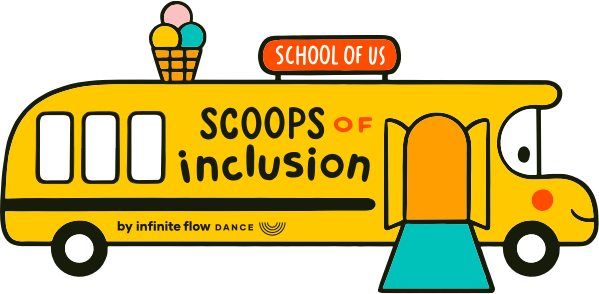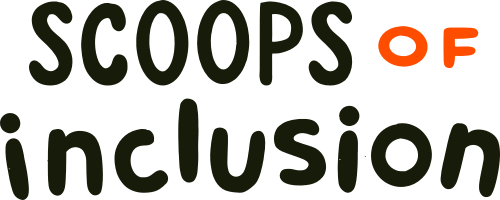How being an inclusive leader changed my life
During my childhood, I was told over and over that my body wasn’t made for dancing. After a stroke that temporarily paralyzed me from the neck down while in college, I got trapped into believing that my body was broken. And after 3 sexual assaults, I could only see my body as an object of abuse.
This led to years of body shaming, turning to fad diets, and even rejecting coffee dates because I couldn’t accept me or my body.
However, as a result of teaching and preaching every day for 5 years at Infinite Flow that EVERY-BODY CAN DANCE and that each person has a dancer inside themselves, regardless of size, shape, height, race, color, age, or disability, I have come to accept my body for what it is and be grateful for its ability to move and express.
When you are exposed to the beauty of diversity and humanity, what you thought as unsightly becomes beautiful and what you thought were your flaws become your strengths.
Inclusion is about us, not “them”™ This is not about one group helping another. This is about each of us taking part in being the change.
Let’s make this world a better world together.
Marisa Hamamoto
Founder, Infinite Flow Dance
Executive Director + Producer, Scoops of Inclusion
Want to know more about my story? Watch or listen to my interview with Marie Forleo:
Why is inclusion important?
Our world and society are seeing strong currents of change, where we are acknowledging some patterns and systems that are not inclusive of all people. We have a real opportunity right now to shape a more positive and safer culture for everyone. We at Infinite Flow, we especially want to make sure diversity is celebrated and people with disabilities are included. We know that, because most schools have transferred to a virtual classroom environment due to the global pandemic, children are missing out on very important social developments that often teach them how to connect and interact with others. Scoops of Inclusion aims to fill some of those gaps, and also highlight the importance of disability inclusion, which is often not addressed enough in classrooms and across society.
What is DEI?
Diversity, Equity, and Inclusion (DEI) is an umbrella term used to describe the framework and actions taken to ensure that we have a fair and just society for everyone, not just for a select few.
To break down the terms:
Diversity refers to the different kinds of people within an organization, location, or community.
Inclusion refers to actively ensuring all people are given the same amount of opportunities to grow and perform, regardless of their identity.
Equity refers to everyone being given what they need in order to thrive; that does NOT mean everyone gets the same thing because a person’s needs may be different.
Ex: A student with a reading disability and a student with a hearing impairment both have needs, but they are not the same needs.
These drawings from John Maeda’s 2019 Design in Tech Report, and adapted from Shel Siverstein’s Giving Tree, illustrate and expand on equality, equity, and justice further. Based on this, you’ll see that the ultimate goal is to fix the root system that creates the inequities.
DEI topic categories include:
Disability Inclusion
LGBTQ+ Rights
Multiculturalism
Immigration Inclusion
Anti-Racism Work
Gender Equality
Religious Equality
Socio-Economic Equity
Etc.
Reflection Exercise
When you think of the word “disability”, what are the first 3 words that come to mind?
Recall a time you were left out. How did this make you feel?
Disability Inclusion
1 in 4 people have a disability. Globally, that is more than 1 billion people in the world. Yet, despite that, people with disabilities are still stigmatized and don’t have equal access to many things in life. Though it’s been 30 years since the American Disability Act was passed by Congress, the unemployment rate for people with disabilities has not changed from 70-80% since 1990. There is much work to be done.
“Disability Inclusion” is the specific inclusion of people with disabilities, both physical, visual, auditory, neurodivergent, and developmental. This inclusion work often requires accommodations, or adjustments made to meet unique needs and circumstances. Common accommodations include ramps, captions, sign language interpretation, and large print materials. Accommodations not only provide access to those with disabilities but benefit all of us. For example, captions can come in handy if you learn better through reading or when you stream a video on your phone with the sound off.
Scoops of Inclusion focuses on Disability Inclusion. However, the diverse identities of the characters in the film has allowed us to take an intersectional approach to address Disability Inclusion.
Definitions of Disability
Traditionally disability is regarded as a medical condition and impairment, thus disability has been interpreted as something that is “bad” or “sad”. However, disability is also an identity and there are many who are “disabled and proud”. I share with you three definitions and models of disability. There are many more. At Infinite Flow, we focus our work on the Social and Cultural Models of disability.
Medical Model: Disability is a personal health condition. Impairment. The “traditional” definition of “disability”.
Social Model: In 2011, the World Health Organization (WHO) redefined disability as “a mismatched interaction between the features of a person’s body and the features of the environment in which they live” in their 2011 World Report on Disability.
Cultural Model: Disability as an identity and a way of life.
Adapted from Kat Holmes Mismatch: How Inclusion Shapes Design
Inclusion Inspires Innovation
Many accommodations that were initially invented to provide access to people with disabilities have turned out to be some of the biggest innovations in the world. For example, as mentioned in our short film, the typewriter was invented from a blind woman seeking to write a love letter. Other examples include sliding doors, the OXO peeler, touch pads, and curve cuts. However, it can also mean how people learn and work varies and we need to be conscious of that. In our schools, it’s especially important that we are creating school cultures that makes everyone feel accepted and that allows all students to maximize their learning and learn together.
Start with Self
Whether you are an educator or a parent/guardian, in order to effectively facilitate a lesson or discussion following Scoops of Inclusion, it is critical to assess your own level of inclusivity. We all have various beliefs, assumptions, and opinions that we hold because of our personal experiences, upbringing, or social conditioning. It is our role to become aware, and engage and question these long-held ideas, investigate where they come from, and get curious with ourselves to see if we actually think they are true or if they were just given to us and accepted as true.
Implicit Bias is our unconscious beliefs and assumptions about groups of people based on certain attributes (ability, skin color, gender, sexuality, etc) that lead us to treat them or behave in certain ways. Just like we have all been socially conditioned, we all have some level of implicit bias about something. Because it is unconscious, we may not even be aware we are doing or saying things to certain people differently than others. Therefore, we need to reflect on our biases and bring them to our conscious awareness.
Examples of what implicit biases in the classroom could look like:
A teacher with implicit bias about children with learning disabilities causes the teacher to lower their expectations of those students. Instead of giving students the accommodations needed, the teacher instead makes things much easier. Why is this a problem? It creates the possibility that the student will not learn as much or they might develop a lower sense of esteem because of the lower expectations.
A teacher with implicit bias about Black students from low-income communities causes the teacher to assume their behavior and acting out is attributed to their home environment or cultural differences, which might cause the teachers to give consequences. However, the teacher is missing that the student is actually reading 2 grade levels behind and can’t access the material. What the student needs is supplemental reading support and some 1:1 time so the student can catch up.
A parent has implicit bias about autism, believing that people with autism don’t like social situations and won’t develop socially like their peers. As a result they isolate their child with autism instead of supporting them to make friends and socialize at a level they are comfortable with. This could exacerbate any underlying issues and actually create co-dependence on the parent instead of letting the child develop independence at their own pace.
Take a moment to ask yourself what biases you may have towards certain groups of people.
Lead with Heart
DEI is a lifelong journey. I continue to be a student while sharing my knowledge and experiences of leading and building Infinite Flow, and I encourage you to do the same. Depending on your own identity and existing familiarity with DEI, you may find yourself lacking confidence, exposure, and understanding in the subject matter. Along the way, you may recognize “faults” in your past actions and thought patterns.
Don’t judge, don’t beat yourself up, and acknowledge that you are going through a critical moment of learning and unlearning. Know that, we as human beings are not perfect, and we each have the capacity to grow and learn at any stage in our lives. It’s great for our children to see grownups continue to learn.
The most important thing to remember here is to lead with heart. Do you want to create a safe space welcoming to all in your classroom? Do you want to cultivate a family of openness and acceptance?
Go back to your answer to “When was a time you were left out? How did it make you feel?” We have all experienced some form of exclusion at some point in our lives. Thus, we have the ability to be empathetic and compassionate towards one another.
As you watch the film, take note of the following:
Which parts of the film are relatable to your own lived experiences? Can any of these experiences be shared with your students or children?
What did you newly discover?
Are there any parts that make you uncomfortable or uneasy? Take a moment to think about why?
Contents
We recommend going through the guide in the order below.
Contact:
info@infiniteflowdance.org
NOTE from Infinite Flow HQ: We are a slim team with no one working full time. We will spend an average 1 hour per weekday on customer service and answering emails. Should an answer be found in the guide, we will simply ask you to refer to the guide, so we ask that you read the guide in full. This guide will be updated in realtime on this website. Thank you for your cooperation.








